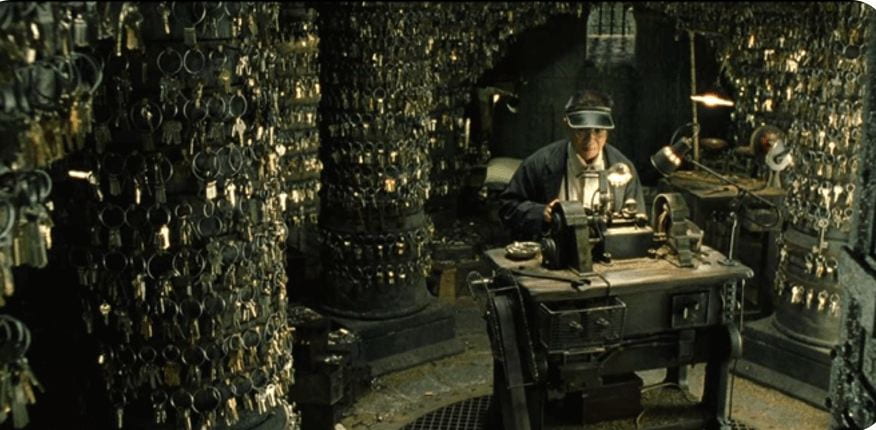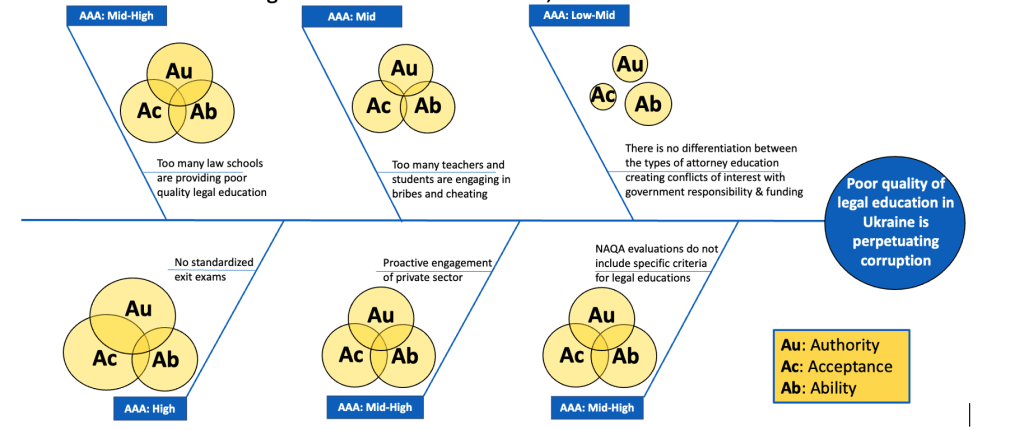Guest blog written by Ilhom Aliyev, Yousif Folathi Alkhoori, Manoj Kumar, Mike Ramirez, Frederick Tarantino
MLD 103MA: Problem Driven Iterative Adaptation (PDIA) in Action: Development Through Facilitated Emergence is among the best classes at Harvard Kennedy School. This hidden infinity stone, 2-credit class challenges you to solve real-world, complex problems using the PDIA approach.
The tried-and-true PDIA process puts a learning structure in the way we look at complexity in local contexts from multiple perspectives. From a high-level, implementation includes a step-by-step approach of breaking down problems into its root cause, finding entry points, searching for possible solutions, taking actions, reflecting on what you learned, adapting, and repeating until the true solution is developed.
This semester, we were divided into teams to tackle real-world solutions. Our team, MY FM Inspiration, were given the challenge of examining legal education reform in Ukraine. Our authorizer was Artem Shaipov, a legal specialist and task leader for the USAID New Justice Program in Ukraine. In the first week, our team realized this problem had many dimensions to it.
There was an abundance of information to consume, and competing literature on what the problem actually was with legal education. To make the problem more difficult, many of us came from western legal education structures, but the Ukrainian legal education structure was very different, and in many ways still based off a Soviet Union era paradigm. Our team dived thickly into the topic with great humility and was focused on gathering as much information and learning as fast as possible. Our first fishbone diagram had nearly ~50 ribs and reflected the discoveries we obtained after the first two weeks.

It was hard to see a clear picture at the beginning. We found ourselves trying to dig past fake problems and problems that were just a lack of a specific solution. It was clear that PDIA was the correct method to use in this case because there was nothing linear about the challenges and potential solutions facing legal education in Ukraine. We had to fight the urge to try and find answers too quickly. The problem seemed to have a hundred gaps that each required individual keys and mastery.

But as we began to refine our questions and highlight topics of interest, we were able to gain much clarity during our stakeholder interviews with senior members of Ukrainian government, academia and private sector. Our team moved with a shared purpose, met new people every week, broke through comfort levels, and optimized our strengths while be cognoscente of our weaknesses. Every single week we gained context and perspective and polished our products, ideas, entry points, and activities. The endless white boards and black boards behind Professor Andrews slowly started to make sense.

Key Takeaways
MY FM Inspiration had many key learnings we took away from the course about the PDIA process while addressing our problem. For example, we learned that every product we made was going to be redone through iteration. The first fishbone diagram (seen above) eventually turned into a fishbone diagram that was much clearer, and actionable.

This is because we did not ever stop asking “why” and deconstructing the problem, and meta-problems to its root causes. The fishbone diagram was not the only product that evolved on our path. Our team constitution, change space assessment, Authority, Acceptance and Ability (AAA) analysis, entry points, design space, and ideas changed throughout the program.
Another key finding is that new doors appear the farther you dive into dialogue. Two examples of this included (1) discovering key government stakeholder interests in engaging with private sector associations more, such as AmCham, and (2) learning that the primary individual who was blocking legal education reform had a personal interest in adopting frameworks from Singapore.
When we realized this, one of our team members was able to leverage his experience in AmCham to make connections, and another teammate was able to connect our team and authorizer with the former Deputy Director of the Ministry of Education in Singapore.
Insights
The key insights we made about our problem was that there are seven main areas with different entry points and unequal AAA assessments. While legal education reform seems like a project that everyone would be in support of, we realized that there are agencies and individuals who benefit from the status quo and leaving corrupt or inefficient practices in place. People we came across feared losing assets and money and saw reform as a threat. We kept coming across suggestions that relied on waiting until there was a change in government administrations. This seemed like a risky approach, which is why we worked hard at finding different entry spaces to nudge our way into, such as discovering the relationship between an authorizer and a think-tank he started that had a strategic partnership in Singapore.
Another key insight is that a solution may be very counter-intuitive at times, but we should be open to where the data takes us. For example, usually improving efficiencies in a project involves more money, but for the solution we came across we needed less money. Law school education reform required a market correction that needed to allow for more educational autonomy and less money being invested into law schools by the central government.
One of our most promising paths forward had to deal with creating more opportunities for government agencies to engage with private sector associations. After pressing the President of the National Agency of Higher Education Quality Assurance to consider improving criteria for accrediting law schools, we found that there was not political appetite to do so alone. Rather, he recommended that if this pursuit was led by private associations, it would be more meaningful for his agency to support at that point. This finding was made in our final week, which was a testament of needing to stay adaptive.
Our last insight was based on the common theme of breaking Soviet-era paradigms. This led to our proposal of investing in a legal education reform awareness campaign where our authorizer could find supporters at all levels of the legal education community and reach out to new groups that were never considered prior. In this case, we recommended international donors who have interest in law enforcement because it was important to begin the narrative to change the Soviet Union paradigm that each police officer needed to go to law school; this was saturating the legal field, creating too many lawyers and decreasing the quality of education and the profession all around. It would be important to emphasize that separating the law school from law enforcement would not remove state funding for police officers, but perhaps increase funding for law enforcement academies because money would be freed up by removing state spending on law school.
Words of Wisdom
If we had to share any wisdom with future students and practitioners, keep an open mind to the problem you get assigned to, become a question master, and practice kindness. When our team learned we would be exploring the topic of legal education reform in Ukraine, most of us did not know what to think. There are certainly more illustrious and distinguished topics to explore in international development. But at the end of the program, our team wanted more.
PDIA requires you to be comfortable asking questions; even the ones that seem “dumb.” For the two weeks, our team made several assumptions about the setup of legal education in Ukraine. As we collided with information that made no sense in an American construct, we realized that the reading and discussions with the authorizer had some gaps in information. PDIA inherently involves a lot of vulnerability because it requires team members to stay humble and learn. This is not easy for individuals are used to being subject matter experts on topics.
Finally, to create a very close team quickly, practice kindness. Each week we dedicated time to create acts of kindness between us. Kindness has a way of breaking down barriers between new team members very quickly. It lets each other know that the person you are working with has compassion and was willing to take time out of their day to think about the well-being of their team members. And some acts of kindness were very cheesy, which showed vulnerability and built comfort even faster.
Farewell
This class takes students to the intersection of academia and application. This experience allowed us to feel the pains of a real-life project and use PDIA in the face of unknowns, challenges and uncertainty. By following the PDIA process, we were able to realize victories and discoveries incrementally. This allowed us to strengthen our tools and end the class with greater confidence of using the PDIA process in the future.
PDIA is a toolkit that gives practitioners a formula to address complexities. It provides teams with a game-plan to tackle great uncertainties with a learning paradigm that fosters thickly engaging with insiders and outsiders, adapting to discoveries, brainstorming ideas, and reflecting often. PDIA makes real-world differences in situations that seem unsolvable. Our team is grateful for having participated in this one-of-a-kind class. Students looking to make a difference in the world should apply now while MLD 103MA is still a hidden gem because eventually it will be the most sought-after class on campus that goes to bidding among the other must-have classes on campus.
Watch the video and view the slides of the PDIA in Action event held in May 2021.
This is a blog series written by students at the Harvard Kennedy School who completed “PDIA in Action: Development Through Facilitated Emergence” (MLD 103) in March 2021. These are their learning journey stories.
